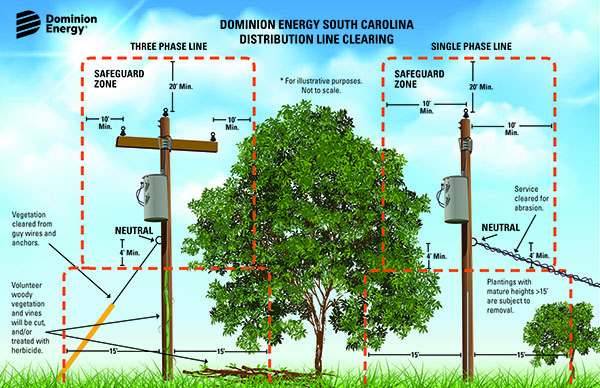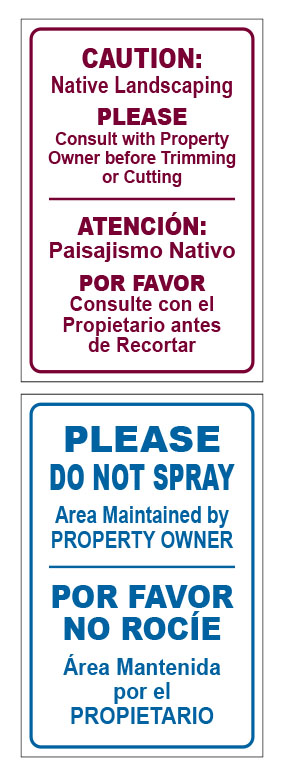Approximately every four years, the power company – formerly SCE&G, now Dominion Energy – trims trees and other plants growing too close to the power lines in our area. Dominion’s website is pretty clear about why and how they trim trees. Please see Dominion’s Trees, Trimming & Power Lines for details.
If you have mature trees growing near powerlines, trimming is almost inevitable. This is just not something you can negotiate about. You can, however, minimize unhappy butchering of plants by making wise landscape choices going forward and by maintaining plants under powerlines properly. Please see the visual provided by Dominion to determine what sized plants you can place near powerlines.

Many properties in our neighborhood have power lines running along either one side of their property and/or the back property line. If you are like I am, you probably want to plant along your property line to create vegetative buffers to give you privacy and provide landscape appeal. So, how do you create a pleasant landscape and create a visual buffer when you have power lines overhead? Choose plants very carefully! The safest bet is to plant shrubs whose mature height won’t reach the power lines. If you plant trees, plant them far enough away from the lines so that they will never interfere with the wires. This means you have to research mature plant dimensions before you make landscape decisions. Obviously, smaller trees and shrubs can be planted closer to the lines than larger one. If you layer your plantings, you can have a nice dense buffer even with plants that are only five to eight feet tall. Always check tags on plants for mature heights. Many plants have dwarf versions that may work better for your situation than full-sized plants.
The second step in avoiding drastic utility line spraying or cutting is to carefully maintain your landscape near power lines. Don’t let volunteer trees or vines take over and get out of control. Weed and remove anything that will grow too high or twine around wires. If you have some landscape plants that seem to be getting too high, keep them trimmed back so they won’t be seen as a threat by line maintenance crews.

The final recommendation is to place signs in your yard to discourage spraying of herbicides by utility workers. Typically, a year or so after maintenance crews trim under lines, they return and spray herbicides to knock back sprouts of what they consider to be problematic volunteers (like oak or cherry laurel). A utility forester at Dominion suggested the following wording: “Please do not spray, area maintained by property owner.” Taking that suggestion, I created a sign in English and Spanish to post in my yard. Preventing severe cutting is trickier. Dominion’s policy is to cut back anything that they think will interfere with wires. Crews are supposed to be trained to know what plants will get too big, but I have a lot of native plantings in my yard that, ironically, are less likely to be recognized by crew members, so I created another sign to address that issue. It says, “Caution: Native Landscaping. Please consult with property owner before trimming or cutting.” I had these signs professionally printed on metal hoping that they would hold up for many years and look as official as possible. You are welcome to copy them. I used Fast Signs on Two Notch Road to print my signs because I had a prior relationship with them, but I’m sure there are other print shops who could do the same thing. I paid $25 for each 12″ x 18″ sign.
I hope this information helps others in the neighborhood. You can contact me at vallg29205@gmail.com if you have questions. Keep in mind, though, that the suggestions here are based on my interpretation of conversations with Dominion’s utility forester and are not direct guidance from Dominion.

